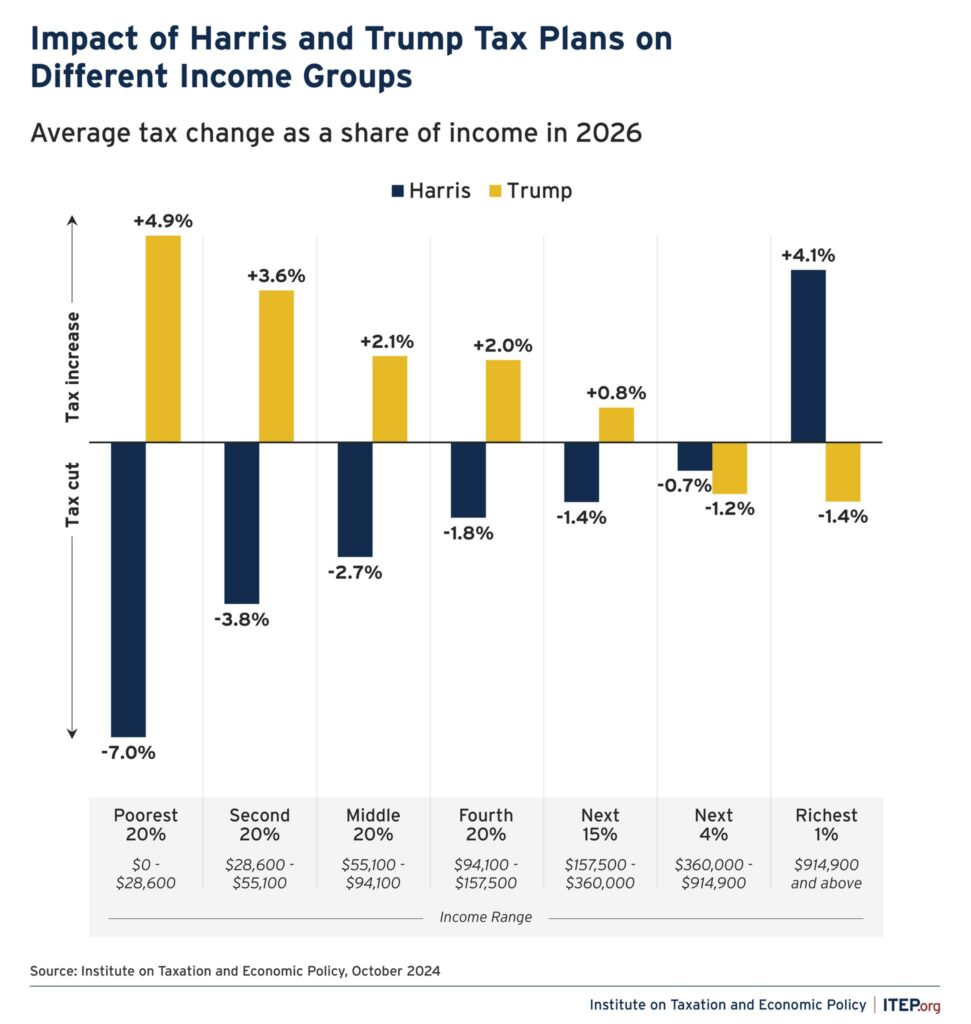Tomorrow, many of us are heading to the polls to vote for our next President. While most voters have already made up their minds, a few folks are still on the fence—major side-eye, right? One of the key issues on the ballot is tax policy, and it’s easy to get lost in percentages and jargon. But what do these proposed cuts and increases actually mean in dollars and cents? The Institute on Taxation and Economic Policy recently broke down how Kamala Harris’s and Donald Trump’s tax plans would impact the average American. So, let’s cut through the noise and look at real examples of people in different income brackets. By turning percentages into actual dollar amounts, we can get a clearer picture of how these changes could affect wallets across America.
The Poorest 20%: Making Up to $28,600 a Year
Take Keisha, a single mother working part-time and making around $25,000 annually. Here’s what her tax burden would look like in 2026 under each plan:
- Harris’s Plan: A 7% tax cut on $25,000 means Keisha would pay approximately $1,750 less in taxes. That’s significant, freeing up money for rent, groceries, or even a small emergency fund.
- Trump’s Plan: With a 4.9% tax increase, Keisha would actually see her taxes rise by about $1,225. For someone living on a tight budget, that extra burden could be a real setback.
The Second 20%: Earning Between $28,600 and $55,100
Consider Marcus and Teresa, a young couple both working full-time at just above minimum wage, with a combined income of around $45,000.
- Harris’s Plan: A 3.8% tax cut would mean they save about $1,710 on their taxes. This could help them with childcare expenses or put a little away for future plans.
- Trump’s Plan: With a 3.6% tax increase, they’d face an additional tax bill of around $1,620. That’s a hit they’d probably rather avoid, especially as they balance living costs.
The Middle 20%: Making $55,100 to $94,100 Annually
Let’s look at Jordan, a high school teacher with a salary of $60,000.
- Harris’s Plan: His 2.7% tax cut would save him roughly $1,620. For Jordan, this could be put toward student loan payments, savings, or even a well-deserved vacation.
- Trump’s Plan: Under a 2.1% increase, Jordan would pay an additional $1,260 in taxes. That’s money that could’ve been useful for everyday expenses or savings goals.
The Fourth 20%: Income Between $94,100 and $157,500
For Chanelle, a registered nurse and single mom making $100,000, the plans diverge further.
- Harris’s Plan: Chanelle would get a 1.8% tax cut, equating to about $1,800 in savings. That’s money she could set aside for her daughter’s college fund or her own retirement.
- Trump’s Plan: Chanelle would see a 2% tax increase, which would mean an extra $2,000 out of pocket. That could put a strain on her budget, especially as costs rise.
The Next 15%: Earning Between $157,500 and $360,000
Let’s look at Jerome, a software engineer making $200,000 a year.
- Harris’s Plan: Jerome’s 1.4% tax cut would save him about $2,800. While that might not make a huge difference for someone with his income, it’s still a decent amount to have on hand for investments or personal savings.
- Trump’s Plan: A 0.8% tax increase would mean Jerome pays an extra $1,600. It’s a smaller increase but could still add up over time.
The Next 4%: Income Between $360,000 and $914,900
Now, take Lisa, an executive making $500,000 annually.
- Harris’s Plan: Lisa would see a 0.7% tax cut, saving her around $3,500. At her income level, it’s a modest cut, but every bit counts.
- Trump’s Plan: Lisa would benefit more here with a 1.2% tax cut, keeping an additional $6,000 in her pocket. This is a noticeable amount for someone in her income range and could be invested or saved.
The Wealthiest 1%: Earning Over $914,900
Finally, let’s look at David, a CEO making $1.5 million annually.
- Harris’s Plan: Under Harris’s proposal, David would face a 4.1% tax increase, meaning he’d pay an additional $61,500 in taxes. For high earners like David, the tax burden is significant but designed to offset cuts for lower-income groups.
- Trump’s Plan: David, however, would get a 1.4% tax cut, saving him $21,000. That’s a solid amount, and at his income level, it can be a welcome boost.

Key Takeaways in Dollars
- Harris’s Plan is structured to favor low- and middle-income Americans with significant tax cuts, especially for those earning under $100,000. For example, Keisha, Marcus, Teresa, and Jordan would see real, tangible savings, allowing them to improve their financial stability. High earners like David, however, would face substantial increases to help fund these cuts for others.
- Trump’s Plan gives no cuts to lower-income and middle-income earners, like Chanelle and Jordan, while giving the most relief to the top earners. For David and Lisa, the Trump plan would translate to real savings, allowing wealthier taxpayers to retain more of their income.
Ultimately, these dollar amounts reveal how differently each plan allocates tax burdens and benefits across income levels. For lower- and middle-income Americans, Harris’s plan could provide more relief, while higher earners would likely find Trump’s plan more favorable.
GET OUT AND VOTE!
